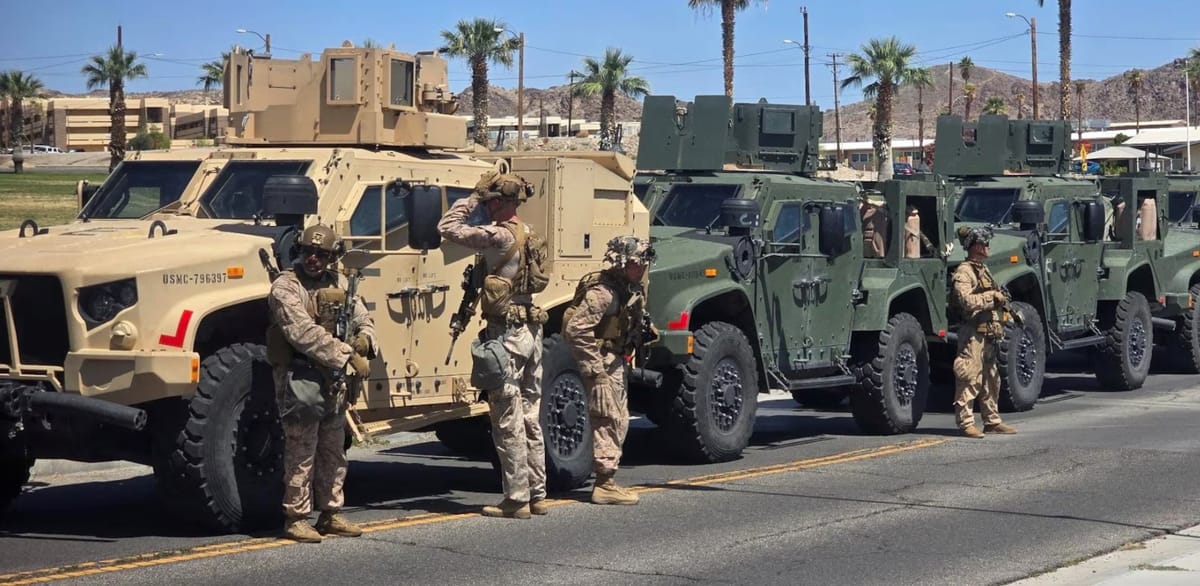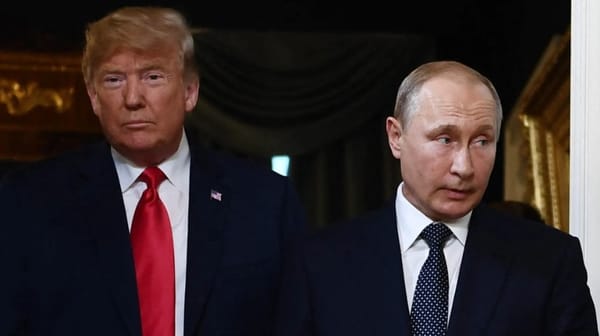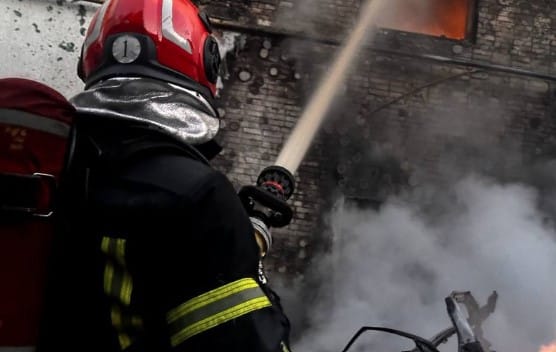Trump Deploys Marines and National Guard to Los Angeles Amid Immigration Protests: An In-Depth Report

Introduction
In a move that has reignited debate over presidential power, civil liberties, and immigration enforcement, President Donald Trump has ordered the deployment of approximately 700 U.S. Marines and 4,000 National Guard troops to Los Angeles. The deployment, which began over the weekend and intensified on Monday, comes in response to escalating protests against the administration’s aggressive immigration raids. Local and state officials, including California Governor Gavin Newsom and Los Angeles Mayor Karen Bass, have condemned the federal action as an overreach and a dangerous escalation, with Newsom announcing legal action to challenge the president’s authority.
This report provides a comprehensive account of the events leading up to the deployment, the legal and political controversy it has sparked, the impact on Los Angeles and beyond, and the broader implications for American democracy and immigration policy.
Timeline of Events: From Raids to Deployment
June 6: Immigration Raids Ignite Protests
The crisis began on Friday, June 6, when Immigration and Customs Enforcement (ICE) agents, accompanied by other federal agencies, executed a series of workplace raids across Los Angeles. High-profile operations targeted locations such as a Home Depot in downtown LA and Ambiance Apparel in the Fashion District, resulting in the arrest of more than 40 individuals accused of immigration violations and the use of fraudulent documents[1][2][3].
The raids were met with immediate resistance. Family members, labor leaders, and activists gathered at the sites to protest the arrests, leading to confrontations with federal agents. Among those detained was David Huerta, president of the Service Employees International Union (SEIU) of California, whose arrest galvanized the labor movement and immigrant rights groups nationwide[4][3:1].
June 7–8: Protests Escalate, National Guard Deployed
By Saturday, protests had swelled in size and intensity, spreading from downtown LA to neighborhoods such as Paramount and Compton. Demonstrators blocked streets, confronted law enforcement, and attempted to impede further raids. Some protests turned violent, with reports of rocks, bottles, and even Molotov cocktails being thrown at officers, who responded with tear gas, pepper spray, and rubber bullets[1:1][2:1][3:2].
That evening, President Trump authorized the deployment of 2,000 National Guard troops to Los Angeles—an extraordinary move that bypassed the traditional requirement for a governor’s request or consent[5][6]. By Sunday, Guard units equipped with military gear were stationed throughout downtown, forming barriers around federal facilities and immigration detention centers[7][8][9].
June 9–10: Marines Arrive, Protests Continue
On Monday, the Pentagon ordered an additional 2,000 National Guard troops and 700 Marines from the 2nd Battalion, based in Twentynine Palms, California, to Los Angeles. The Marines’ assignment was to secure federal property and support the Guard, marking the first use of active-duty troops in a domestic law enforcement context in Los Angeles since the 1992 Rodney King unrest[7:1][8:1][10][9:1].
While Monday’s protests were calmer, with thousands rallying peacefully at City Hall and outside federal detention centers, tensions remained high. Over 100 demonstrators were detained, and law enforcement maintained a heavy presence, including helicopters patrolling the skies[7:2][8:2][11]. The cost of the deployment was estimated at $134 million, with Pentagon officials testifying that the operation could last up to 60 days[11:1][9:2].
Legal and Constitutional Controversy
Unprecedented Federal Action
President Trump’s decision to federalize the California National Guard and deploy Marines without the governor’s consent is unprecedented in recent U.S. history. The last time a president called up the National Guard to respond to civil unrest in a state without a governor’s request was in 1965 during the Watts riots[12][10:1][6:1]. The move has sparked intense legal and constitutional debate over the limits of presidential authority.
The Legal Basis: Insurrection Act and Beyond
Traditionally, the Posse Comitatus Act prohibits the use of federal troops for domestic law enforcement, with the notable exception of the Insurrection Act. The Insurrection Act allows the president to deploy troops to quell insurrections or enforce federal law, but it has rarely been invoked without a state’s request[13][6:2]. In this case, Trump’s memorandum cited 10 U.S.C. § 12406, which allows the president to federalize the National Guard in cases of rebellion or when federal law cannot otherwise be enforced[13:1].
Legal experts are divided on whether the administration’s actions meet the threshold for such extraordinary measures. California Attorney General Rob Bonta has filed suit, arguing that the deployment violates the Constitution and exceeds the president’s authority[14][15][16]. Governor Newsom has called the deployment a “manufactured crisis” and “an extraordinary overreach of power,” vowing to fight it in court[17][14:1][10:2][9:3][16:1].
Political and Community Response
Local Leaders Push Back
Los Angeles Mayor Karen Bass and Police Chief Jim McDonnell have both criticized the deployment, insisting that local law enforcement is capable of managing protests and that the arrival of federal troops creates logistical and operational challenges[7:3][8:3]. Bass noted that the majority of protests have been peaceful and accused the Trump administration of exaggerating the threat to justify military intervention[7:4][8:4][18].
Governor Newsom has been especially vocal, accusing Trump of “stroking a dangerous President’s ego” and using the National Guard and Marines to escalate tensions for political gain[7:5][17:1][10:3][16:2]. Newsom’s lawsuit contends that commandeering the state’s National Guard without consent is both illegal and immoral[14:2][15:1][16:3].
National and International Reaction
Senator Jack Reed, ranking member of the Senate Armed Services Committee, expressed grave concern over the use of active-duty Marines in a law enforcement capacity, warning that such actions undermine the traditional separation between military and civilian authority[8:5][13:2]. Human rights organizations, including Amnesty International, have condemned the deployment as a dangerous escalation that threatens the right to peaceful protest and risks violating civil liberties[19].
Community Impact
The immigrant community in Los Angeles, already on edge due to the raids, has been further traumatized by the heavy military presence. Many families fear separation or deportation, and community organizations have reported a surge in calls for legal assistance and support[4:1][19:1][3:3]. The arrest of labor leader David Huerta has galvanized unions and immigrant rights groups, fueling nationwide protests in solidarity with those detained in Los Angeles[4:2][19:2].
The Protests: Voices, Violence, and Vigilance
Protest Dynamics
What began as small gatherings quickly grew into mass demonstrations, with thousands rallying across the city. While the majority of protests have been peaceful, there have been significant confrontations between demonstrators and law enforcement. Protesters have decried the raids as racially discriminatory and an attack on the city’s immigrant communities, while some have resorted to vandalism and clashes with police[1:2][2:2][4:3][19:3][3:4].
Law enforcement has responded with a range of tactics, from declaring unlawful assemblies to deploying tear gas, rubber bullets, and flash-bang grenades. The use of force has drawn criticism from civil rights groups and local officials, who argue that it has only inflamed tensions[1:3][2:3][4:4][19:4][3:5].
Spread Beyond Los Angeles
The unrest has not been confined to Los Angeles. Protests have erupted in at least 30 other cities, including San Francisco, Sacramento, Houston, Chicago, New York, and Philadelphia[4:5]. Many of these demonstrations have been organized by labor unions, immigrant rights groups, and community organizations in response to the raids and the arrest of Huerta[4:6][19:5].
The Broader Context: Trump’s Immigration Agenda
A Maximalist Approach
President Trump’s actions in Los Angeles are the latest and most dramatic manifestation of his administration’s hardline immigration agenda. During his 2024 campaign and since returning to office, Trump pledged to conduct the largest deportation operation in U.S. history and to use every available tool, including the military, to enforce immigration laws[18:1]. The raids in Los Angeles are part of a broader national crackdown targeting sanctuary cities and workplaces suspected of employing undocumented immigrants[2:4][18:2][3:6].
Testing Executive Power
By federalizing the National Guard and deploying active-duty Marines without state consent, Trump is testing the boundaries of executive authority. This approach goes beyond his response to the 2020 Black Lives Matter protests and marks a significant departure from the traditional reliance on state and local control for managing civil unrest[18:3][10:4][6:3].
Legal and Historical Precedents
National Guard Deployments in Los Angeles
The National Guard has been deployed to Los Angeles several times in the past, most notably during the Watts riots in 1965 and the Rodney King unrest in 1992[12:1][10:5][6:4]. In both cases, the deployment was made at the request of state officials. The current situation is unique in that it is the first time in 60 years that a president has acted without a governor’s request, raising significant legal and constitutional questions[12:2][10:6][6:5].
The Insurrection Act and 10 U.S.C. § 12406
While the Insurrection Act has been invoked 30 times in U.S. history, it has not been used without a state’s request since 1992[13:3][6:6]. Trump’s reliance on 10 U.S.C. § 12406 as a stand-alone authority is legally untested and is now the subject of court challenges[13:4][15:2][16:4]. Legal scholars warn that such actions set a troubling precedent for future presidents and could erode the balance of power between the federal government and the states[13:5][15:3][16:5].
The Human and Financial Cost
Community Trauma
The raids and subsequent military deployments have left many in Los Angeles’ immigrant communities fearful and traumatized. Reports of families separated, workers detained, and neighborhoods under heavy police and military surveillance have heightened anxiety and distrust of government[4:7][19:6][3:7].
Financial Impact
The military operation is projected to cost the Defense Department at least $134 million, primarily for travel, accommodation, and meals for deployed troops[11:2][9:4]. Critics argue that these resources could be better spent on community support and services rather than militarizing city streets[11:3][9:5][16:6].
Looking Ahead: Legal Battles and Political Fallout
Lawsuits and Court Challenges
California’s lawsuits against the Trump administration seek to block the federalization of the National Guard and the deployment of Marines, arguing that the president has overstepped his constitutional authority[14:3][15:4][9:6][16:7]. The outcome of these legal battles could have far-reaching implications for the limits of presidential power and the future of federal-state relations in the U.S.
Political Ramifications
The deployment has deepened the divide between the Trump administration and Democratic leaders in California and other states. It has also intensified the national debate over immigration policy, civil liberties, and the appropriate use of military force within U.S. borders[17:2][18:4][10:7][16:8].
Community Organizing and Resistance
Immigrant rights groups, labor unions, and civil liberties organizations are mobilizing for continued protests and legal action. The arrest of David Huerta and the heavy-handed response to demonstrations have galvanized a broad coalition of activists, signaling that the conflict over immigration enforcement and presidential power is far from over[4:8][19:7][3:8].
Conclusion
President Trump’s deployment of Marines and National Guard troops to Los Angeles marks a watershed moment in the ongoing struggle over immigration policy, presidential authority, and the right to protest in America. What began as a series of workplace raids has escalated into a constitutional crisis, with profound implications for civil liberties, federalism, and the fabric of American democracy. As legal challenges proceed and protests continue, the nation watches closely, aware that the outcome will shape the future of immigration enforcement and the balance of power between Washington and the states for years to come.
https://www.usatoday.com/story/news/nation/2025/06/09/la-protests-timeline-ice/84106969007/ ↩︎ ↩︎ ↩︎ ↩︎
https://en.wikipedia.org/wiki/June_2025_Los_Angeles_protests ↩︎ ↩︎ ↩︎ ↩︎ ↩︎
https://www.nbcnews.com/news/us-news/la-protests-immigration-raids-ambience-apparel-home-depot-rcna211814 ↩︎ ↩︎ ↩︎ ↩︎ ↩︎ ↩︎ ↩︎ ↩︎ ↩︎
https://time.com/7292495/ice-immigration-protests-la-national/ ↩︎ ↩︎ ↩︎ ↩︎ ↩︎ ↩︎ ↩︎ ↩︎ ↩︎
https://www.npr.org/2025/06/10/nx-s1-5428071/los-angeles-protests-national-guard-presidential-powers ↩︎
https://www.opb.org/article/2025/06/10/trump-and-la-what-laws-give-him-authority-to-send-federal-troops/ ↩︎ ↩︎ ↩︎ ↩︎ ↩︎ ↩︎ ↩︎
https://apnews.com/article/los-angeles-protests-ice-national-guard-9dfd2d025070bb6060d908dd3cf9b1f0 ↩︎ ↩︎ ↩︎ ↩︎ ↩︎ ↩︎
https://www.reuters.com/world/us/marines-arrive-la-under-trump-orders-protests-spread-other-cities-2025-06-10/ ↩︎ ↩︎ ↩︎ ↩︎ ↩︎ ↩︎
https://www.washingtonpost.com/nation/2025/06/10/la-protests-ice-live-updates/ ↩︎ ↩︎ ↩︎ ↩︎ ↩︎ ↩︎ ↩︎
https://www.bbc.com/news/articles/cyvmz3egr7do ↩︎ ↩︎ ↩︎ ↩︎ ↩︎ ↩︎ ↩︎ ↩︎
https://www.cnn.com/us/live-news/la-protests-ice-raids-trump-06-10-25 ↩︎ ↩︎ ↩︎ ↩︎
https://www.usatoday.com/story/news/nation/2025/06/09/president-national-guard-protests/84115770007/ ↩︎ ↩︎ ↩︎
https://www.justsecurity.org/114282/memorandum-national-guard-los-angeles/ ↩︎ ↩︎ ↩︎ ↩︎ ↩︎ ↩︎
https://www.cbsnews.com/news/trump-national-guard-california-lawsuit-gavin-newsom/ ↩︎ ↩︎ ↩︎ ↩︎
https://www.npr.org/2025/06/10/nx-s1-5428234/marines-national-guard-los-angeles-trump-lawsuit ↩︎ ↩︎ ↩︎ ↩︎ ↩︎
https://thehill.com/policy/defense/5341321-newsom-says-trump-deploying-another-2000-national-guard-troops-to-la/ ↩︎ ↩︎ ↩︎ ↩︎ ↩︎ ↩︎ ↩︎ ↩︎ ↩︎
https://time.com/7292191/trump-newsom-national-guard-california-los-angeles-protests-legal-challenge/ ↩︎ ↩︎ ↩︎
https://www.pbs.org/newshour/nation/trump-pushes-ahead-with-his-maximalist-immigration-campaign-in-face-of-la-protests ↩︎ ↩︎ ↩︎ ↩︎ ↩︎
https://amnesty.ca/human-rights-news/usa-national-guard-los-angeles-ice-raids-dangerous/ ↩︎ ↩︎ ↩︎ ↩︎ ↩︎ ↩︎ ↩︎ ↩︎




